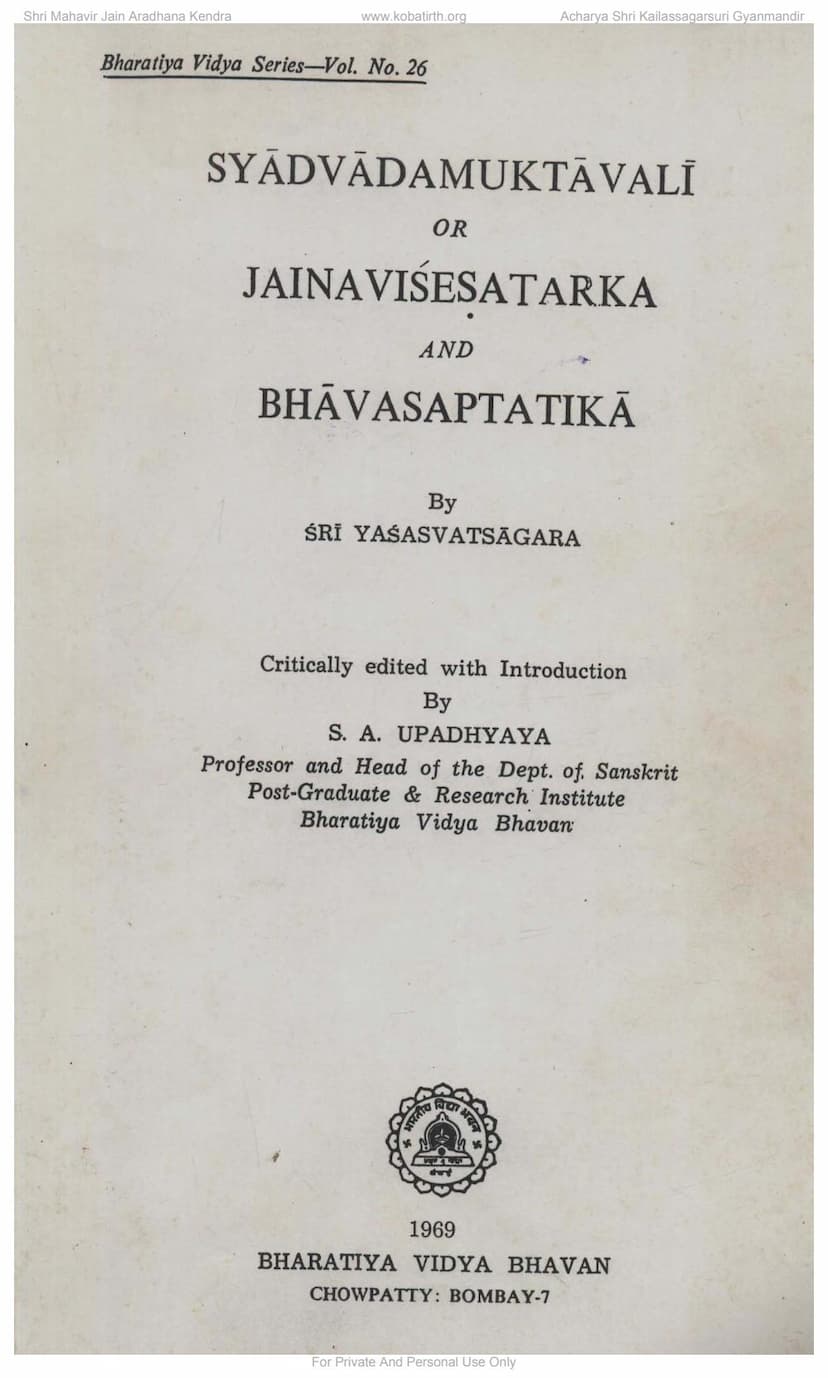Syadwad Muktawali
Added to library: September 2, 2025

Summary
Here's a comprehensive summary of the provided Jain text, "Syadvada Muktavali" or "Jaina Visesatarka" and "Bhava Saptatika," based on the introduction and text excerpts:
Book Title: Syadvada Muktavali (also known as Jaina Visesatarka) and Bhava Saptatika Author: Sri Yasasvatsagara Editor: S. A. Upadhyay Publisher: Bharatiya Vidya Bhavan
Overall Purpose: This publication presents critical editions of two previously unpublished works by the Jain author Sri Yasasvatsagara. The first, Syadvada Muktavali (or Jaina Visesatarka), focuses on the Jain theory of predication (Syadvada) and the two types of valid knowledge (pramana): direct perception (pratyaksa) and inference (anumana). The second, Bhava Saptatika, deals with various topics in Jain astrology (Jyotisha).
Syadvada Muktavali / Jaina Visesatarka:
- Content Focus: The book is divided into three chapters (stabakas or gucchakas), each containing twenty-five verses.
- First Chapter: Explains the doctrine of Syadvada (the doctrine of manifold predication or "perhaps"). It also covers the six Jain categories (padarthas), the concepts of the general (samanya) and the specific (visesa), and pays homage to the author's gurus.
- Second Chapter: Focuses on pratyaksa pramana (direct perception). It discusses the soul (jiva), knowledge (jnana), its types like yatharthajnana (true knowledge), samaropa (superimposition), viparyaya (error), samsaya (doubt), and anadhyavasaya (indecision). It also details the kinds of causes and the specific types of direct perception: avagraha, iha, avaya, sudharana (stages of perception), avadhi jnana, manahparyaya jnana, and kevala jnana. It concludes with references to the Arhats and the author's gurus.
- Third Chapter: Deals with paroksa pramana (indirect knowledge/inference). It outlines the five types of indirect knowledge: smarana (memory), pratyabhijna (recognition), tarka (reasoning), anumana (inference), and shruta (scriptural knowledge). It elaborates on inference, discussing the relationship between the probans (hetu) and the probandum (sadhya), the concepts of vyapti (invariable concomitance), paramarsa (reasoning), the five-membered syllogism (avayava), and the role of drstanta (example) with examples of sadharmya (similarity) and vaidharmya (dissimilarity).
- Author's Style and Background:
- Yasasvatsagara was a scholar from Gujarat, belonging to the Tapā gaccha tradition.
- He was a devout follower and pupil of Sri Yasahsagara and Sri Charitrasagara.
- His works reveal a deep understanding of Logic (Nyaya), especially the Syadvada philosophy and the concept of pramana. He also studied Astronomy and Horoscopy.
- His language is described as simple and lucid, though sometimes compact and aphoristic. He was influenced by authors like Vādidevasūri.
- He showed a tendency to use less common words and achieved poetic qualities through alliteration, apt examples, and expressive metaphors.
- The work is considered an elementary text-book suitable for beginners (sishuprabodhaya).
- Manuscript Details: The critical edition is based on a single manuscript from the Bhandarkar Oriental Research Institute, Poona. The manuscript is described as being in fair condition, written in Jaina Devanagari script, and estimated to be at least two hundred years old. The editor notes various scribal errors and a lack of professional diligence in the manuscript.
- Titles: The work is known by two titles: Syadvada Muktavali (as indicated in colophons and later verses) and Jaina Visesatarka (mentioned in the opening stanza), both of which are used in this edition to distinguish it from another work with a similar title.
- Metrical Analysis: The verses are composed in various meters, predominantly Anustubh and Sardulavikridita. The editor notes the author's moderate mastery of metrics.
Bhava Saptatika:
- Content Focus: This work, comprising 72 stanzas, is dedicated to Jyotisha (astrology). It covers topics such as:
- Divasalagna Sadhanam (calculation of the diurnal ascendant)
- Ayanamsa Karana (calculation of the ayanamsa or precession of the equinoxes)
- Ratrilagna Sadhana (calculation of the nocturnal ascendant)
- Natonnatasadhana (calculation of declination)
- Dashamabhavasadhana (calculation of the tenth house)
- Vimsopaka (a specific astrological calculation)
- And other related astrological calculations and concepts.
- Purpose: The brief treatment of these topics suggests it's an elementary textbook for learning astrological calculations.
- Author's Background: The work is by the same author, Sri Yasasvatsagara, further indicating his diverse scholarly interests beyond logic and epistemology.
- Manuscript Details: The critical edition is based on three manuscripts. The editor details their provenance, condition, script, and scribal characteristics. One manuscript from BORI has a colophon dated V.S. 1751, while another from LD (Ahmedabad) is dated V.S. 1762. The editor notes numbering inconsistencies and scribal errors across the manuscripts.
- Title: The title is Bhava Saptatika (or sometimes Bhava Saptaţika), meaning "seventy verses related to states or conditions," referring to astrological houses or states of being.
- Date of Composition: The date of composition is given in verse 71 as V.S. 1740, Krishna Panchami, Friday.
- Metrical Structure: The verses are primarily in Anustubh and Indravraja meters.
Editor's Contribution: Professor S. A. Upadhyaya undertook the critical editing of these works, drawing on his training in manuscriptology. He expresses gratitude to various scholars and institutions for their assistance. His work involves comparing manuscripts, correcting errors, providing textual notes, and offering detailed introductions that shed light on the author's life, works, and the specific content of the texts.
In essence, this publication provides valuable access to two important Jain texts that were previously unavailable to scholars, offering insights into the philosophical and astrological traditions within Jainism through the learned works of Sri Yasasvatsagara.